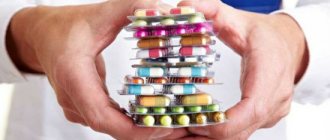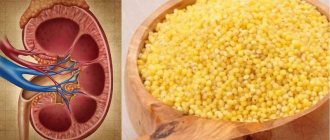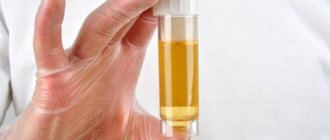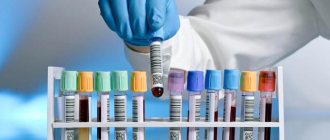Features of the drug's action
The drug is produced in tablet form. Each tablet contains 50 mg of the active ingredient, a nitrofuran derivative.
The drug contains additional substances - calcium stearate, starch, lactose. The tablets are in the shape of a flattened cylinder, bright yellow in color and are individually packaged.
One blister contains ten tablets. The drug is available in packaging of 10 or 20 tablets, and is also available in a jar containing 50 tablets of the product.
The tablets belong to the nitrofuran group of drugs and have a bacteriostatic and bactericidal effect.
The drug is active against gram-positive and gram-negative microorganisms. The product is able to fight salmonella, shigella, E. coli, trichomonas, but has little effect on anaerobes and purulent infections.
The components of the drug "Furazolidone" are nitrofurans, which destroy the enzyme system of pathogenic microbiota and prevent further reproduction.
The medicine does not inhibit the functioning of the body's immune forces. By suppressing the growth and proliferation of pathogenic bacteria that provoke inflammation of the mucous membrane of the bladder, the drug acts on the intestinal microflora. The first improvements when taking the drug occur within a few days.
The main advantage of the Furazolidone tablet is to improve the functioning of the patient’s defenses. The medicine helps eliminate pathogenic bacteria. The medication is evacuated from the body with urine and is not toxic to the excretory organs.
What affects the color of urine in a healthy person?
Urine contains many components that require removal from the body. Among them are pigments formed during the breakdown of hemoglobin, collectively called urobilin. This component includes uroerythrin, urochrome, urozein. Urochrome is most abundant in urine, which is what gives urine its yellow color.
Although the color of urine in healthy people is yellow, its shade may vary:
- with a lack of water in the body;
- due to the consumption of certain foods;
- with uncontrolled use of medications;
- during pregnancy;
- when changing your usual physical activity.
Also, the shade depends on the person’s age, metabolic rate, even time of day.
Application of the product
The instructions for use clearly describe how to take it for cystitis. The medication is taken after meals, since on an empty stomach the tablets provoke nausea, vomiting, and discomfort in the digestive tract.
It is better to drink the product with not one, but two glasses of water. The drug is absorbed in the digestive tract and reaches its maximum concentration after five hours.
Furazolidone does not accumulate in tissues and blood because it is quickly metabolized by hepatocytes. It is excreted primarily by the kidneys.
If the mucous membrane in the bladder is damaged by pathogenic microorganisms, large doses of Furazolidone must be prescribed.
The maximum permitted dose for adults is 200 mg at a time and 800 mg per day, that is, 4 tablets and 16 tablets.
This appointment is made when the disease is acute. Then the dosage is reduced - patients drink 2-3 tablets 4 times a day after meals.
The course of treatment lasts 5-10 days, and in case of chronic disease or other infections, the therapy is extended for a couple of days.
School-age children take 1-2 tablets four times a day, and for children under seven years old the dosage is calculated based on the rule: they drink 10 mg of the drug per kilogram of weight.
The interval between taking tablets is determined by pharmacokinetic properties - you should not take the medication more than once every six hours to avoid an overdose of the drug.
To remove decay products, doctors recommend taking the drug with two glasses of liquid.
Good results are achieved by alternating furazolidone and herbal medicines according to the 3/3 scheme in young patients. After treatment of children, a control urine test is performed.
Interaction with other drugs
Furazolidone actively interacts with various medications for allergies, contraceptives, antipyretics, etc. It is necessary to stop taking these medications, if possible, both during treatment with Furazolidone and 2 weeks later. All appointments must be coordinated with your doctor.
If, when prescribing the drug, the patient was being treated with another drug regimen for another serious disease, treatment cannot be stopped, but the possibility of combining medications should be discussed with the doctor.
Overdose and contraindications
Furazolidone is prescribed by a urologist. The doctor will determine the severity of the infection, identify the causes and include pills in the treatment regimen for the disease.
The course of drug therapy and dosage are also determined by the doctor, but on average the drug is taken for no more than ten days in a row.
When taking the medication, no negative effects occur, but an overdose of the drug contributes to the development of acute hepatitis, polyneuritis and general deterioration of health.
In case of an overdose of the drug, drink antihistamines, B vitamins and 1 liter of water.
Before using the medicine, consult your doctor. Contraindications to the use of Furazolidone are as follows:
- acute renal failure;
- sugar deficiency in the body;
- intolerance to the components of the drug;
- pregnancy and breastfeeding;
- liver pathologies;
- diseases of the central nervous system;
- heart pathologies;
- increased susceptibility to nitrofurans;
- the patient's age is less than 1 year.
Use with caution for diabetes mellitus, electrolyte imbalance, anemia and vitamin deficiency due to the risk of neuropathy. The presence of lactose in the tablets is also taken into account - this excludes the use of the product in patients with an allergy to this component.
Side effects of the drug are rare. A patient taking Furazolidone takes into account that in some people it can change the color of urine, giving it a brown tint.
Side effects include disruption of intestinal microflora, nausea, loss of appetite, headache, and breathing problems.
Patients develop allergic reactions, which are observed in the form of rash, urticaria and Quincke's edema.
Patients suffer from dizziness, their body temperature may drop sharply and cough. Is it possible to cancel the drug in this case? Patients are interested. To do this, consult a doctor..
Disturbance of intestinal microflora
Causes and prevention of bright yellow urine
The color of urine excreted by a person is one of the most important indicators of the successful functioning of all body systems. The shade may change slightly during the day, becoming more saturated in the morning and lighter in the evening. This is due to the concentration of coloring pigments, which give urine a normal straw-yellow color. But if the shade changes repeatedly, a natural question arises as to why the urine is yellow. In such a situation, it is worth making an appointment with a doctor as soon as possible.
Causes of bright yellow urine
The chemical basis of urine composition is mostly water. Depending on various factors (age, gender, health status, liquid drunk or food eaten), the color of urine may change. The main attention, especially in the hot season, should be paid to the amount of clean, fresh water consumed per day. With a lack of moisture, the body is not able to adjust the density of urine, as a result of which its concentration increases and the color becomes more saturated.
An imbalance in the body's water balance can be caused not only by decreased consumption, but also by increased consumption of moisture, for example, with profuse sweating during physical activity.
A common cause of urine discoloration is the entry into urine formation reactions of substances that are not characteristic of the body.
Similar compounds come from food products containing bright natural or artificial colors. Medicines from the group of laxatives, many antibiotics and vitamin complexes also have similar properties.
The most unfavorable unnatural coloration is bright yellow urine. It can warn of diseases of the renal system. The cause may also be related to liver pathologies, since accumulated bile pigments turn body fluids and tissues yellow.
Dependence of urine color on drinking and eating
The first reasons that should be analyzed if a person has bright yellow urine are the nature of his food and drinking regimen. Manufacturers of modern food and beverages often add various dyes to their products, which, in their opinion, will make the product more attractive to customers. Such a marketing ploy, even if it brings profit to manufacturers, certainly does not provide any beneficial properties to the body of an adult consumer. On the contrary, artificial dyes do not linger in the tissues, but almost instantly pass into the kidneys to become part of the excreted urine.
Even when consuming natural products grown independently, there is a danger of unnatural coloration of urine.
This is due to the fact that the natural dyes contained in carrots, pumpkin, citrus fruits and other “colored” products from the garden are not inferior in intensity to any artificial analogues.
Urine-coloring medications
Medicines that increase the saturation of urine belong to various groups of drugs:
- antimicrobial agents (Furazolidone);
- laxatives with phenolphthalein;
- antibiotics;
- vitamins of group B, A, C.
The group of vitamin complexes is especially dangerous for children, since multi-colored tasty “candies” left in a visible place will never go unnoticed by children.
What does yellow urine mean in women?
In women, due to certain features of the anatomical structure of the excretory organs, inflammatory diseases of the bladder and kidneys more often develop. In such cases, normal urine will also darken to the color of beer. Possible foaminess is explained by a simultaneous increase in protein in urine.
In young mothers who continue to breastfeed their baby, a brighter color is considered a clear sign of dehydration.
The resulting milk takes all the free moisture into its composition, leaving the remaining systems to suffer. The gynecologist must calculate the required volume of water for patients per day, depending on the age, weight and general health of the women.
Yellow urine during pregnancy
Doctors monitor the health of the expectant mother especially diligently, recommending urine testing before each visit to the gynecologist. The excreted urine is considered a qualitative indicator of the health status of the pregnant woman and child. Lemon-colored urine in pregnant women is associated with the prophylactic use of vitamin complexes, which accumulate in the body and are then excreted through the kidneys. We cannot exclude reasons in the form of colored drinks and food that a woman may consume.
If the expectant mother did not take such vitamins and other medications, and also controlled her diet, but the urine became an unnatural beer color, then this condition indicates a possible disease or complication of the pregnancy. It is worth contacting an antenatal clinic as soon as possible to identify the true causes.
Yellow urine color in men
Men have a more active lifestyle. They have a passion for sports and physical activity. In this regard, increased sweating and loss of water through the skin prevent the formation of normal urine. These are physiological reasons. But there are also pathological ones.
Advantages and disadvantages of the drug "Furazolidone"
The drug has positive and negative effects. The medication perfectly fights bacteria that provoke inflammation of the mucous membrane of the bladder.
With the help of these tablets, unpleasant symptoms such as itching, burning and frequent urination are achieved.
The positive effects of the product begin within the first days after use. The medicine interacts with other medications when prescribed together with tetracyclines and aminoglycosides.
The active substance does not conflict with herbal preparations against inflammation of the bladder mucosa - “Canephron” and “Urolesan”.
Furazolidone is quickly absorbed into the digestive tract, and the concentration in the blood is maintained for 4–6 hours.
The drug has low toxicity and is therefore used in children under one year of age. A positive quality is the affordable price.
Does Furazolidone help given such a low price? Of course yes. Also among the positive characteristics of the drug, it is worth noting less toxicity compared to other drugs, such as Nolitsin and Ciprofloxacin.
The disadvantages of the drug include the following features: the concentration in the kidneys and tissues is extremely low, so only infections of the gallbladder and intestines can be treated. In these places, the medication accumulates better and reaches concentration.
The drug should not be used in patients suffering from severe liver and kidney diseases. Treatment of cystitis with Furazolidone is a way to help the bladder get rid of pathogens and cleanse the mucous membrane of microbes.
Diet while taking the drug
Tyramine, which is found in some foods, can cause severe side effects, such as significantly increased upper blood pressure.
Tyramine is found in the following foods: ripe fruits and chocolate, canned and smoked meat, nuts and legumes, cognac, rum, wine and beer, kefir, yogurt and curdled milk, canned food and pickles, sports supplements.
To protect yourself from side effects and make it safe to take, for 2 weeks after taking the drug you must avoid smoked cheeses, dried fish and meat, sausages and other processed products that require preservation and fermentation. It is also important to give up coffee and cocoa, as well as cocoa-containing products - sweets and chocolates.
Use of medication during pregnancy
During pregnancy, Macmiror can be prescribed only as a last resort, if the benefits of the medicine are predicted to be greater than the negative effects on the expectant mother and fetus. The medicine tends to penetrate the placenta, so such therapy should be treated with special care.
When breastfeeding, it should be taken into account that the main component of the drug is excreted in breast milk. Therefore, you should stop breastfeeding your baby during treatment.
Possible side effects
In rare cases, side effects may occur. If the following symptoms appear, you should contact your doctor:
- increased body temperature;
- itching of the skin;
- joint pain;
- skin rashes or redness;
- sore throat;
- indigestion, diarrhea;
- nausea and vomiting;
- headaches and malaise.
If this is not possible and it is impossible to find an analogue, then breastfeeding must be interrupted while taking the medication. During treatment with antibiotics and Furazolidone, a child may experience candidal stomatitis, skin dermatitis and other manifestations.
It is important to consult a specialist in time, undergo a series of tests to help make the correct diagnosis, and prescribe the necessary course of treatment. Taking any medications on your own is strictly prohibited. The presence of accompanying symptoms plays an important role, so if you notice a change in the color of urine, remember the presence of pain when urinating, other symptoms and impurities in the urine.
- Healthy urine color
- Possible causes of bright yellow urine color
- Change in urine color during pregnancy
- In men
- In children
- Symptoms
- What to do: advice to patients
- Preventive recommendations
Healthy urine color
Normally, urine has a light yellow tint. The specific color depends on the amount of urochrome pigment (the final metabolite of red blood cell hemoglobin). The presence of diseases of the excretory system leads to disturbances in the filtration and selective function of the kidneys.
Impaired filtration in the glomeruli of the kidneys leads to the entry of certain elements into the urine, for example, red blood cells, proteins, leukocytes, and failures in reabsorption lead to the return of substances back into the blood. For this reason, the patient's urine is colored in a nonspecific shade. The color of a patient's urine is often used to make an approximate diagnosis.
Possible causes of bright yellow urine color
Urine can acquire a richly bright yellow color due to various physiological processes.
What are kidney stones and how to get rid of deposits in a paired organ? We have the answer!
General rules and effective methods for treating cystocele in women are collected in this article.
Do not be alarmed if you notice a change in the color of your urine; most cases of this state of affairs are the result of harmless physiological processes:
- eating special foods that can “color” urine. Today there are few completely natural products left. Manufacturers add many different dyes and preservatives that can affect the color of human urine. This category includes brightly colored carbonated drinks, carrots, and various sweets. In this case, there is no need to worry; doctors recommend that you stop using this product in the future;
- dehydration. It is a fairly common cause of bright yellow urine. The process leads to active reabsorption of water, the concentration of urine increases, and against the background of this process the liquid itself acquires a rich yellow tint. The causes of dehydration are not only a lack of water or hot weather, the pathology is observed against the background of intestinal infections, a number of other diseases, intense exercise, severe toxicosis during pregnancy;
- taking special medications or vitamins. Most active components of medicinal products are not completely absorbed and are excreted in the urine, which can affect its color. These drugs include vitamins B, A, C, and nitrofuran. After the body is completely cleansed of the components of the medicine, the urine will again become its usual color.
Urine of a rich yellow color is found in patients with serious pathologies:
- urolithiasis disease. The formation of salts in the patient's urinary system leads to the formation of sand, then its elements stick together, forming kidney stones of various sizes. Salts gradually absorb liquid, which affects the concentration of urine, including its color;
- gestosis. It is a serious complication in pregnant women in the later stages of pregnancy. The complication is accompanied by constant high blood pressure, swelling of the limbs, face, and proteinuria. In such a situation, dehydration leads to a change in the patient’s usual urine color;
- liver diseases. Urobilin in increased quantities (observed when there is a malfunction of the liver) contributes to the coloration of the patient’s urine in a bright yellow color;
- genetic or individual characteristics of metabolism in the patient’s body. Increased formation of salts leads to constant coloration of urine in a rich yellow shade. In the future, the pathology contributes to the formation of sand and stones, which can cause the development of nephrolithiasis. Be vigilant, take good care of your health, and if you constantly have nonspecific urine color, visit a specialist.
Change in urine color during pregnancy
Urine during this period is the main indicator of the condition of the mother and unborn baby. A urine test is indicated at every visit to the doctor to clearly monitor its composition and color. The bright yellow color of urine in pregnant women is not always a sign of any disease. Many women are prescribed multivitamin complexes that can change the color of urine; taste preferences play an important role.
During pregnancy, the female body takes on the entire burden and is responsible for the viability of the fetus. Continuous operation of the excretory system can lead to its overload and urine coloration in a non-specific shade. Do not panic when a pathology is detected, but you cannot ignore the symptom either. Consult a doctor, the doctor will identify the root cause of the pathological condition and, if necessary, prescribe treatment.
In men
Urine in men also changes color when taking certain medications or eating “coloring” foods. The color of urine of the stronger sex is affected by the abuse of fatty foods and alcoholic beverages. After gatherings with friends, it is recommended to increase the volume of fluid consumed and follow a diet for at least several days after a heavy load on the body.
If the color of urine changes during the course of the disease, the urine acquires a fetid odor, and sometimes the appearance of inclusions of blood, pus, and other impurities is noted. Often the cause of the pathological condition is prostatitis. The disease is getting younger every year, so take preventive measures and monitor the condition of the urinary system.
What is angiomyolipoma of the left kidney and is it life-threatening for the patient? We have the answer!
Find out what bilirubin in urine means and what diseases it indicates in this article.










